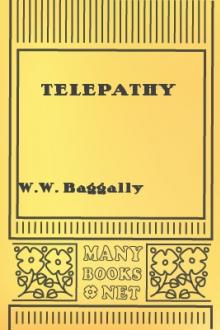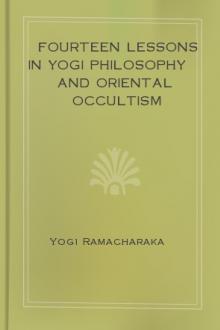Telepathy by W. W. Baggally (e reader manga .txt) 📕

- Author: W. W. Baggally
- Performer: -
Book online «Telepathy by W. W. Baggally (e reader manga .txt) 📕». Author W. W. Baggally
For silent thought transference occasionally electrical contrivances are resorted to. These are placed in different parts of the hall, and when being pressed by the foot or hand of the agent will convey a message to a certain part of the stage upon which the percipient (who may be blindfolded) rests his foot.
There is another silent method which can be worked by a confederate who is placed behind a curtain close to the chair on the stage upon which the blindfolded percipient sits. The confederate watches the performer who stands amongst the audience and reads through a spyglass what he is writing on his tablet when putting down what members of the audience wish to be done. The confederate then communicates the contents of the writing to the percipient on the stage by whispering or by an electrical apparatus. The position of the performer or agent while he is writing in a clear hand on his tablets with his back to the stage easily enables a confederate to read the writing.
Then there is the silent method of a French conjurer, some of whose performances I have witnessed, which consists of suggesting or "forcing" the spectators to do certain things, each action having a corresponding number which he conveys to his lady assistant, who is blindfolded, by touching her foot with his after she has come down from the stage and stands by his side amongst the audience.
The "time-coding" method consists of silently counting by the agent and percipient at the same rate, starting from a preconcerted signal and ending at another preconcerted signal. The performer amongst the audience has in his hand a piece of paper on which is written the number that he wishes to silently convey to the other blindfolded performer on the stage. At the moment that he bends his head to look at the number he begins silently counting at a certain rate; a confederate behind the scenes begins counting at the same rate from the moment that the performer bends his head. When the performer lifts his head he ceases counting, so does the confederate. Each number written on the paper is thus conveyed, and the confederate communicates the total to the blindfolded performer by means of an electrical apparatus or otherwise.
I have attended several performances in public halls in London at which thought transference—so-called—was carried out by the above trick methods.
Sir Oliver Lodge was present with me at one of the performances at which the time-coding method was used. He has sent me the following note:—
"I was with Mr. Baggally on one of these occasions, and took note of the fact that he could often guess what was being transmitted by the performers quite as well as they could themselves. We sat in a box looking at them, and he often told me before they had spoken what they were going to say (or words to that effect).
"I perceived even without his assistance that the performance, which was stimulated by the success of the Zancigs, was an exceedingly inferior imitation of what they had achieved, and was manifestly done by a code of some kind.
"O. J. L."
Some of the methods resorted to by public entertainers are so ingenious that the spectator is led to believe that genuine thought transference has taken place. The following correspondence, which appeared in the spiritualistic weekly paper called Light, illustrates a case in point. In the number of Light of the 25th October 1902 there appeared this letter headed "Thought Transference":—
"Sir,—A few years ago Mr. and Mrs. Baldwin gave the following entertainment in almost every large town in the three kingdoms. The public were invited to write any question or questions they desired to have answered on a piece of paper, to place it in their pockets, and keep it there without communicating its contents to anyone, and then when they went to the hall their names were called out and their question answered without the papers leaving their possession. About fifty such inquiries were answered each evening without a single failure by Mrs. Baldwin, who sat blindfolded with her back to the audience. From my experience and that of my friends, collusion was impossible, and the only way of accounting for the performance was by thought transference or telepathy between Mrs. Baldwin and those of the audience with whom she was in mental sympathy.
(Signed) "C. A. M."
Commenting on this letter, I wrote to Light, and my communication appeared the following week. It was to this effect:—
"Under the heading of 'Thought Transference,' your correspondent, C. A. M., gives an account of some entertainments by Mr. and Mrs. Baldwin, at which he says" (I here quoted from C. A. M.'s letter, and then continued as follows):—"I never was present at entertainments given by Mr. and Mrs. Baldwin, and therefore cannot express an opinion as to the modus operandi in their particular case, but I would point out that their entertainments bear a close resemblance to those given by conjurers. The explanation of the mystery in a conjurer's case is as follows:—The conjurer asks members of the audience to write their questions secretly, to sign their names at the bottom of the question, and then to fold the pieces of paper on which the questions are written and place them in their pockets. To facilitate the writing he hands pencils round and tablets upon which to rest the pieces of paper during the writing of the questions, or the members of the audience, if they so wish, can retire into an adjoining room and write their questions on a table. The tablets and pencils are then collected by an assistant who is a confederate, who then retires from the hall to the room where the table is. The tablets and table have false surfaces of leather or other material, which, on being removed by the confederate, disclose a layer of carbon paper resting on another of white paper upon which the questions have been recorded unknown to the inquirers. The confederate then proceeds to read the questions with their respective attached signatures, and to communicate them to the blindfolded medium by an electrical apparatus upon which the medium's foot rests, or by other mechanical means."
I signed my letter W. W. B. A fortnight after, the following letter appeared in Light:—
"Sir,—With reference to the communication by W. W. B. referring to the supposed thought transference, and mentioned by another correspondent, C. A. M., in connection with the entertainments of Professor Baldwin (an American conjurer and brother mason), whom I met in Cape Town on two separate occasions, permit me to state that (1) if it is the same Baldwin, he is one of the cleverest illusionists in his special line of trick thought transference, and W. W. B. is quite right. (2) I know that Mr. and Mrs. Baldwin did most of their experiments by trick, because, being one of the chosen committee to test the so-called thought reading, I fixed it absolutely as trickery on the lines indicated by W. W. B.
(Signed) "Berks Hutchinson"
I was gratified to read this letter and to find that my conjecture was correct that the Baldwin performance was a mere exhibition of conjuring.
PART IIITHE ZANCIGS
Some years ago there appeared at the Alhambra Theatre, London, two entertainers—Mr. and Mrs. Zancig—whose performances were of so puzzling a nature that to many who had witnessed them the only explanation of the results obtained appeared to be that genuine telepathy was at play. The Daily Mail newspaper arranged that Mr. and Mrs. Zancig should be subjected to a series of severe tests at its office, and on the 30th November 1906 these were carried out.
On the 1st December the Daily Mail published a full account of these experiments. The publication of this and of other accounts by persons who had witnessed the remarkable performances of the Zancigs led to a heated controversy between the correspondents of the Daily Mail and the Daily Chronicle. Those of the first paper mostly asserted that the performance was an exhibition of true telepathy, while those of the second paper declared that codes—visual and verbal—would account for the phenomena. Previously to the experiment carried out by the Daily Mail I had obtained a letter of introduction to the Zancigs from a friend of mine who had had private tests with them, but as it was necessary to have the permission of the manager of the Alhambra before an interview with the Zancigs could be arranged, I called at the offices of that theatre, and saw Mr. Scott, the manager. I informed him that I was a member of the Society for Psychical Research, which body I told him took the deepest interest in telepathy. I handed him a letter that I had written to Mr. Zancig, and on the 29th November 1906 I received the following communication from the last-named gentleman:—
"Dear Sir,—I received a letter from Miss H. A. Dallas, telling me that you would like to meet us. Now, my dear sir, we would be pleased to make your acquaintance, and have you call for a visit, but if it is for any private show and to be tried and judged if our work is, as we represent, 'two minds with but a single thought,' I will have to say No. We have done nothing since we arrived in London but have callers to test and try us every day, from three to four ladies and gentlemen. My wife and I agreed to all tests they put to us, and all was quite satisfactory. Personally I do not care, but it has been quite a strain on my wife. Should you care to witness our show, you would be able to see us at ten p.m. on the Alhambra stage, but if you care to call and see us, and have a little talk, we both would be pleased to meet you.—Trusting that I am understood, I remain, yours sincerely,
(Signed) "Julius Zancig"
Although the contents of the above letter were of a discouraging nature, I determined to strike the iron while it was hot; therefore, on the evening of the same day I called, accompanied by my wife, at the flat where the Zancigs resided. They were at the time partaking of their evening meal. We apologized for our intrusion, but by the kind way that they received us we were soon put at our ease. I informed Mr. Zancig that I was much interested in telepathy, and that I had personally carried out experiments in this branch of psychical research, and that I was assured of the truth of its existence through the successes that I had obtained.
Mr. and Mrs. Zancig impressed my wife and myself most favourably by their unaffected and simple manner. After a conversation which lasted about ten minutes, Mr. Zancig very kindly spontaneously offered to try some experiments. I will now describe these. Madame Zancig went to the other end of the room farthest away from where Mr. Zancig, my wife, and I sat. She faced the wall with her back to us; Mr. Zancig then wrote with a chalk a line of figures on a slate which he held in his left hand, and called out the





Comments (0)